Remote Patient Monitoring Companies and Market: A Brief Overview

Integration of modern technologies into healthcare brings many positive patient outcomes. What is more, the introduction of wearable devices made instruments like remote patient monitoring possible. When it comes to understanding the phenomenon, there is a number of factors to consider. Yet, the most important thing is that the technology is booming and there is a saturated market for it.
Just consider the following — the health tech market size will surpass $1,176.63 billion by 2032. Nova Advisor anticipates an annual projected growth of 18.7% from 2023 to 2032. It means that healthcare is under heavy digitization and soon enough millions of patients will face relief in the face of innovative means of care provision.
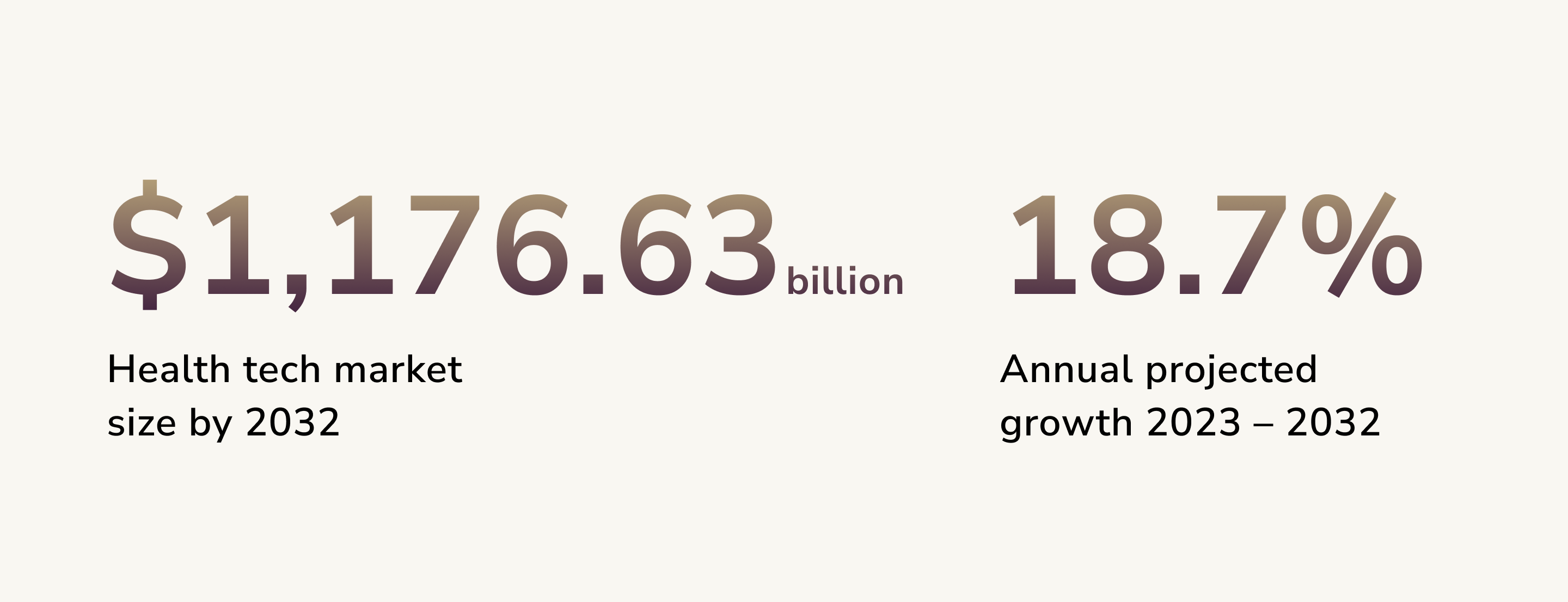
At this point, it is apparent that health tech trends, including the remote health monitoring phenomenon, presented further, are important for creating better patient outcomes and allowing health tech start-ups and enterprises to scale. Here, we would like to make a brief overview of remote patient monitoring systems and explore key companies in the domain that push forward the technology and make tech health as accessible as ever before.
Briefly about Remote Patient Monitoring Systems
Remote patient monitoring systems emerged because of the rise of the Internet of Things (IoT) and mHealth. In other words, the more people became surrounded by technological devices connected to the Internet, the easier it became to any healthcare organization tool they wish. Respectively, to get insights into the nature of remote patient monitoring systems, there are several questions to answer.
What is a remote patient monitoring system?
Remote patient monitoring is a type of technology enabling close monitoring of patients outside a clinical setting. A person can be at home or in some remote area and still be under clinical supervision. Keeping that in mind, remote patient monitoring equipment drastically increases access to healthcare and brings the care provided to another level.
How do remote patient monitoring systems work?
The phenomenon works through remote health monitoring devices. There are different wearable sensors for remote health monitoring, which allow the transmission of varying health metrics. Essentially, the instruments used in the remote patient monitoring tap various digital technologies while establishing close communication between patients and providers. Patients use the sensors to collect data about their health during different times of the day. Then, the data is electronically transmitted to clinicians and technicians, analyzed, and synthesized into valuable insights. Importantly, the data is collected and transmitted through secured channels of health systems, often using high-grade encryption.
Who discovered a remote patient monitoring system?
Remote patient monitoring CMS was invented in the 1970s. A prominent Kaiser Foundation International cooperated with Lockheed Missiles and Space Company to design and implement a remote monitoring system that would communicate health information from a patient without a person being near a health provider. The crucial thing is that the pilot program was integrated into places with low accessibility to healthcare, for instance, rural areas. It means that remote patient monitoring was designed as a system that would boost accessibility to healthcare in locations that do not have proximity to healthcare vendors.
What are the benefits of a remote patient monitoring system?
One of the pivotal aspects of any new technology stems from its benefits. With remote patient monitoring systems, there are numerous benefits to talk about:
- Improving clinical decision making reliant on data. Medical devices for remote patient monitoring systems grant many insights into patients’ health status. Based on such data, healthcare providers can make more informed clinical decisions. Importantly, with the technology, clinicians and technicians can see how a patient's health changes over time, leading to better diagnostics, chronic care management, clinical outcomes, etc.
- Boosting patient self-management and care plan adherence. It can be extremely difficult for people with chronic conditions or those in post-surgical recovery to come to conventional clinical settings for health check-ups. With remote patient monitoring, such patient populations get means for easy-to-use tools that help manage their condition. Besides, patients receive greater chances for better care plan adherence.
- Bringing the cost of care reduction for both payers and vendors. Remote patient monitoring makes frequent hospital admissions and readmissions obsolete. It means patients and vendors will be exposed to shorter lengths of stay, which translates into a lower cost of care. Besides, remote patient monitoring results in a lower cost of inpatient services.
- Increasing net patient revenue. Remote patient monitoring brings improved workflow efficiency and reduced administrative costs. As a result, those factors create preconditions for higher net patient revenue, which is profitable for organizations and healthcare tech companies adopting remote patient monitoring.
- Reducing patient expenses. For patients, coming to healthcare facilities can be a costly endeavor, especially if a person does not live close to one. In such a case, remote patient monitoring reduces the associated costs for in-patient care. Imagine, when being monitored remotely, a person does not need to take time off at work and spend hours driving to the closest healthcare provider.
- Building up access to care. Remote patient monitoring CMS brings vendors closer to patients. It offers care to people regardless of their geographic location. It can be used for patients in rural areas, as well as help connect individuals to specialists that do not have access to the given area. Finally, remote patient monitoring serves as a great way to drastically reduce appointment breaches.
- Bringing forward patient engagement. Remote patient monitoring is most often used to boost patient engagement strategy. The technology offers people instruments for a better understanding of personal health. At this point, when patients have deeper insights into their health, they can better understand the care plan.
- Optimizing clinical staff efficiency to address shortages in clinical staff. Remote patient monitoring provides positive outcomes for clinicians. It helps them prioritize care delivery and focus on each case based on close, as well as real-time patient monitoring. Many tools of remote patient monitoring can be integrated with the healthcare provider’s ERM, which reduces issues like duplicative documentation. In the face of current healthcare staff shortages, remote patient monitoring can help decrease the burden of overscheduling, which translates into greater staff efficiency.
- Preventing the spread of infectious diseases. One major advantage of remote patient monitoring stems from the ability to prevent the spread of infectious diseases. In the age of COVID-19, such a possibility can bring massive benefits. Reducing the number of in-patient visits decreases the likelihood of transmitting an infectious disease. It can be extremely important for immunocompromised patient populations.
With AI and Big Data in healthcare, RPM sytems will undergo significant transformation. Without a doubt, with the increased application of technology, new advantages will emerge.
What are potential drawbacks of remote patient monitoring?
Before we go further, it is necessary to consider potential drawbacks of RPM. Although remote patient monitoring brings numerous benefits to both patients and healthcare professionals, the following things should also be kept in mind:
- Privacy and Security Concerns. There is a risk of data breaches, unauthorized access, or misuse of personal information. As RPM involves collecting and storing sensitive patient data, robust cybersecurity measures are crucial to protect patient data and ensure its confidentiality.
- Unethical Use of Data and Algorithms. The use of AI and ML in remote patient monitoring raises concerns about potential biases and a risk of algorithms being used for unethical purposes.
- Technical Challenges. A reliable internet connection and technical know-how from both patients and healthcare providers are necessary for RPM. Also, technical glitches or software issues can disrupt data collection and communication, impacting care delivery.
- Potential for Overdiagnosis and Overtreatment. The abundance of data collected through RPM may lead to overdiagnosis of conditions, leading to unnecessary medical interventions and potential harmful clinical outcomes.
- Cost and Reimbursement Issues. The cost of implementing and maintaining RPM technology can be significant, and the issues with insurance reimbursements can limit access to the technology for certain patients.
- Lack of Standardization and Regulations. A lack of regulations across different healthcare systems and standardization in RPM practices can lead to confusion and inconsistencies in data collection, interpretation, and treatment decisions.
How does a remote patient monitoring system help the elderly?
When it comes to particular patients, the one linked to one of the most vulnerable populations, namely the elderly, remote patient monitoring can have specific advantages. Most importantly, it fills the gaps between home health visits. What does it mean? Essentially, taking daily biometric readings through a smart device provides healthcare professionals with early warnings showing when a patient’s condition is getting worse. In other words, through a remote patient monitoring program healthcare providers can get timely information on when an elderly patient requires immediate help, which results in saving patients’ lives.
What healthcare providers can use a remote patient monitoring system?
There is a myriad of healthcare providers that can use remote patient monitoring CMS. Essentially, every provider who has sufficient IT infrastructure and professionals who can work with such technology can implement it. Referring to some examples, there is GYANT with its AI-based products that help collect and analyze patients’ health information. The healthcare providers couple remote patient monitoring and Artificial Intelligence (AI) to bring the best patient outcomes. There is also Medopad, a healthcare provider using patient-reported information with genomics. As a result, different healthcare providers use various approaches to make the most of remote patient monitoring systems.
What would happen without a remote patient monitoring system?
Without remote health care monitoring, healthcare would become less accessible. Besides, in the case of the COVID-19 pandemic, the lack of opportunities that decrease the number of in-patient visits inverse the likelihood that the disease will spread. In general, without remote health care monitoring, both patients and healthcare vendors will be less happy.
How much does remote patient monitoring solution cost?
There is a range of price options available for remote patient monitoring software. The price range starts from $0.99 and can reach about $8 per patient per month. Importantly, companies can also get access to full-service solutions managed by third parties. It makes the application and support of the technology much easier. Yet, such options cost about $20-$30 per patient per month. It is always good to research available options and determine which one meets your needs the best.
Remote Patient Monitoring Definition and Purpose
At this point, a reader has a general overview of the remote patient monitoring phenomenon and understands how it can benefit patients and healthcare providers. However, further, there is a more comprehensive illustration of what remote patient monitoring is and what are the major objectives of the technology.
Comprehensive remote patient monitoring definition
Remote patient monitoring systems are a distinct method of healthcare delivery utilizing most of the latest technological advances linked to the Internet of Things and wearable technology. These are information technology tools directed at gathering patient data, namely their biometrical points outside any given traditional healthcare setting. In such a case, remote patient monitoring is all about transferring healthcare out of the conventional setting into places where people work and live. As experts indicate, the phenomenon is grounded in the technologies building the bridge that blur the line between a traditional healthcare setting and a patient.
Key objectives and goals of remote patient monitoring systems
Remote patient monitoring systems make patients’ lives easier and more comfortable. For vendors, it offers a constant stream of data that can be transformed into more informed decisions thus resulting in better care plans and improved patient outcomes. However, when it comes to key objectives of remote patient monitoring systems, one should outline the following:
- Make healthcare more accessible for people living in isolated locations.
- Make healthcare services more available for patients with limited mobility.
- Provide seamless access to medical specialists without the need to undergo unnecessary bureaucratic procedures.
- Improve communication and coordination of care.
- Improve patient self-management.
- Grant a better understanding of health conditions and factors influencing them.
Following these objectives ensures remote patient monitoring becomes a truly innovative and beneficial technology. Importantly, healthcare vendors can also set some additional goals when employing the phenomenon.
Remote Patient Monitoring and Health Tech Market
As we’ve mentioned before, the healthcare software development market is booming. There is a project of massive growth that awaits the industry and various markets. When it comes to the remote patient monitoring market specifically, there are some additional insights to offer.
The experts suggest that the patient monitoring devices market will reach a staggering $89.75 billion by 2032. As of 2022, the market is worth $41 billion. Importantly, such a massive growth will be driven by further development of monitoring technologies integrated into smartphones and various wireless devices. Aspects like mobile cardiac telemetry monitoring devices and mobile personal digital assistant systems will be more accessible.
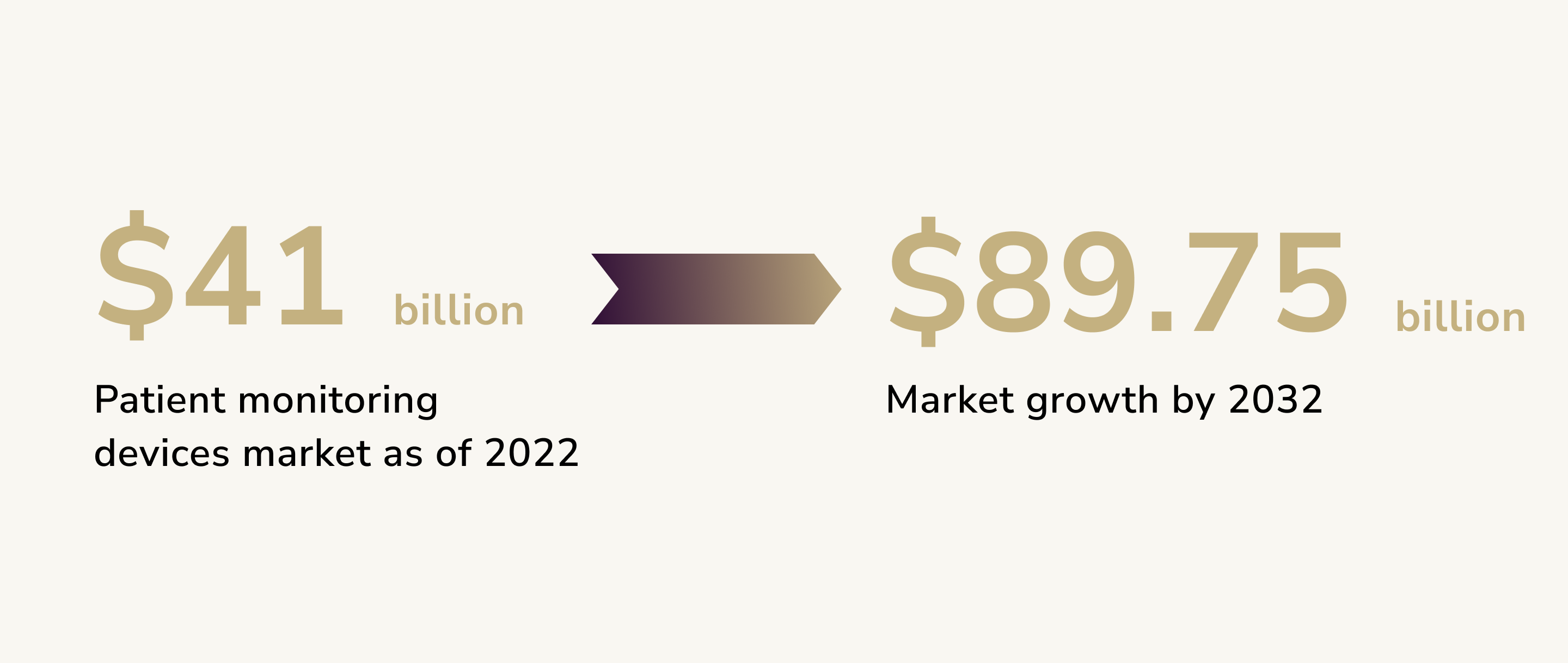
The COVID-19 outbreak pushed the development of remote patient monitoring CMS even further. Serving as an improved chronic disease management system, the technology has also been adapted to serve as a COVID-19 prevention measure. At this point, while allowing to cut costs for managing chronic conditions and the spread of coronavirus, remote patient monitoring has gained traction among businesses, organizations, and governments. It means a greater degree of investment and potential returns, which brings new entrants to the market.
Remote patient monitoring market’s growth factors
There are several key elements that push further the development of technology. Apart from the COVID-19 pandemic, which was mentioned above, the instruments are driven by the fact of increment in the geriatric population and the need for healthcare vendors to reduce expenditures in care provision.
- Increase in the geriatric population. According to the World Health Organization, the share of the geriatric population, the ones about 65 years old, have increased from 6% in 1990 to 9% in 2019 and is expected to reach 16% in 2050. With healthcare getting better, people are living longer. It means that with the growing average life expectancy, there will be more older people living at the same time. Respectively, the growth of the geriatric population increases the demand for remote patient monitoring systems. More elderly patients mean more chronic conditions that need to be dealt with. At this point, remote patient monitoring is the answer to the growth of the geriatric population, and the technology is driven by the given phenomenon at the same moment. It all translates into remote patient monitoring market expenditure.
- Reduction of healthcare expenditure. Remote patient monitoring improves the access to healthcare and reduces the number of unnecessary visits patients have to make to receive care. The technology saves a lot of time and improves healthcare providers’ efficiency, as it was mentioned earlier. Essentially, it all means fewer expenditures on factors like hospitalization, nursing, and traveling. Healthcare vendors are continuously looking for ways of making care less expensive and their expenditures lower. Remote patient monitoring grants that and ensures more and more healthcare providers will use it, thus driving the demand even further.
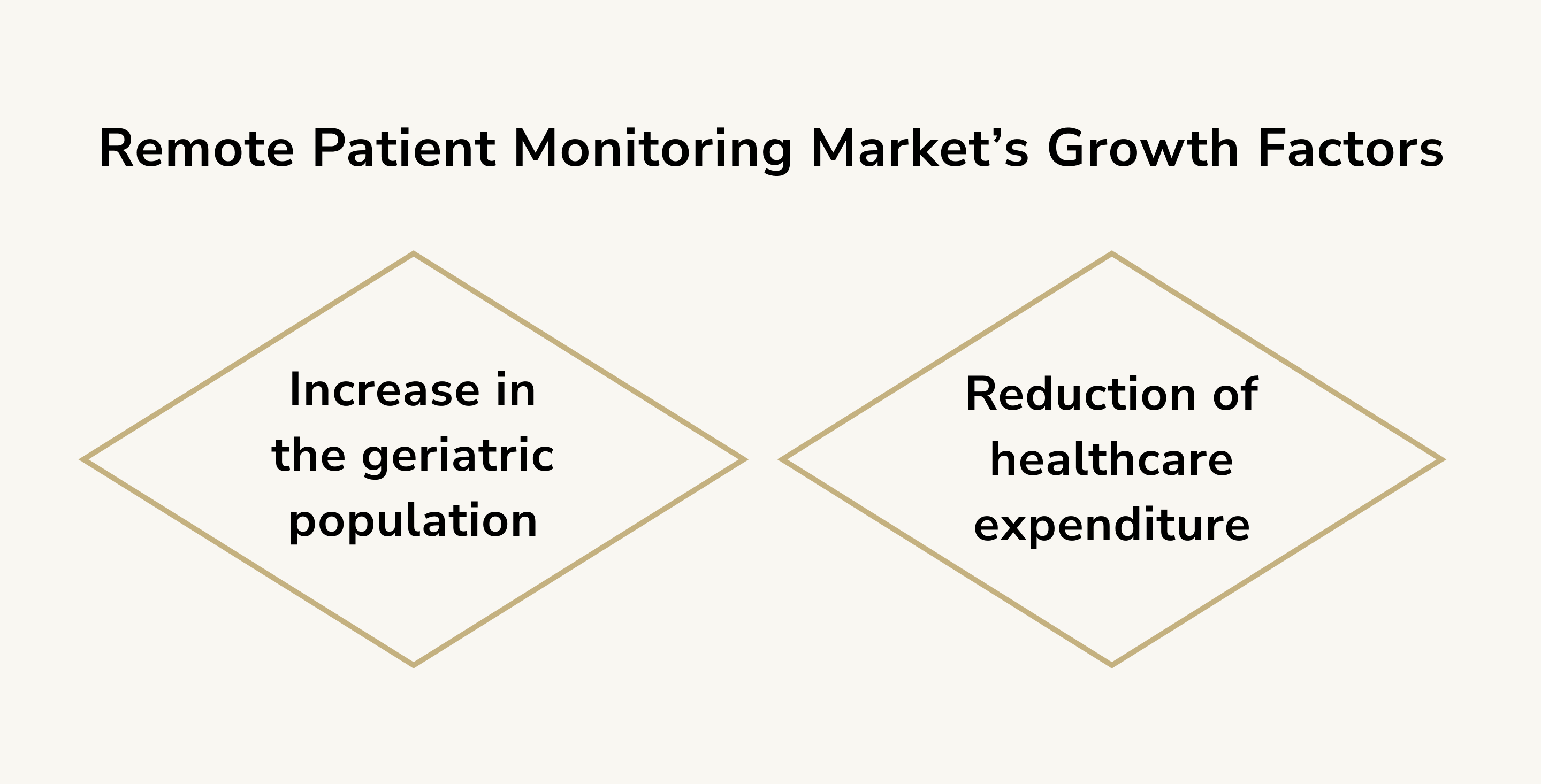
These two factors make remote patient monitoring as appealing as never before. Apparently, the elements lead to the growing demand for the tool, which means more investment and market expenditure.
Remote Patient Monitoring Devices and Software Common Features
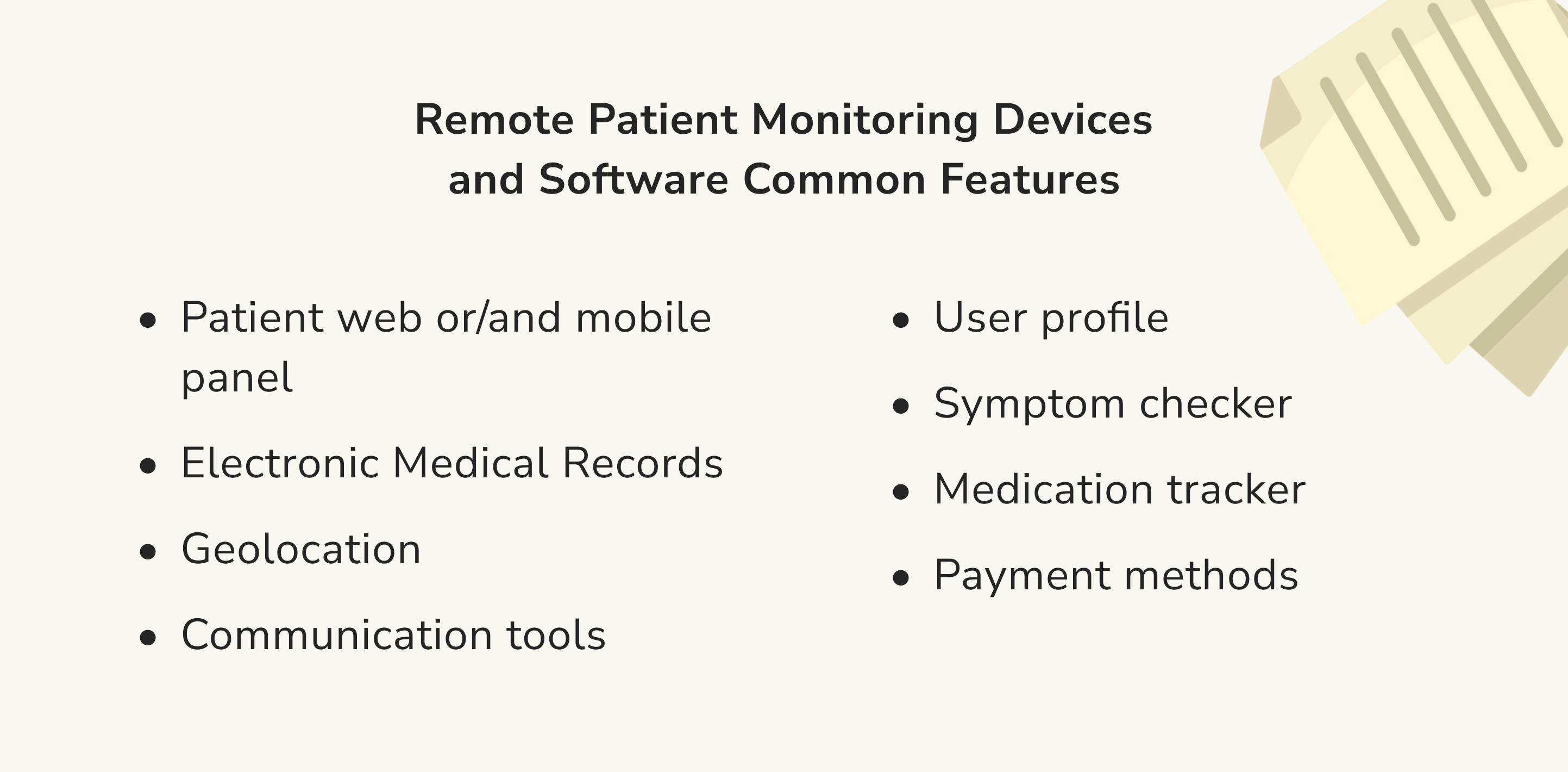
Remote patient monitoring software can be different. It all depends on the quality of research you make and the software’s features you receive for a respective price. However, there are particular elements that are foundational for remote patient monitoring software.
Patient web or/and mobile panel
Any given remote patient monitoring software should include a panel for available medical services. There, one can find a list of health conditions subjected to treatment along with the form for scheduling an appointment. What is more, the panel should include tabs for things like mental, medical, and family health history. Such elements are a must for remote patient monitoring software.
User profile
It is one of the first features a user should encounter when using remote patient monitoring software. User profile displays data on aspects like a patient’s address, location, time zone, gender, email, phone number, and alternative emergency number. In addition, the user profile illustrates the history of all visits and scheduled appointments. When coupled with tools like Google Calendar, a user receives timely reminders, thus knowing when it is time to schedule an appointment.
Geolocation
Remote patient monitoring makes patients’ lives easier because it reduces the number of times a person needs to travel to the nearest healthcare facility for an in-patient visit. So, there will always be a request for a user’s geolocation, to help one find pharmacies and healthcare vendors nearby. It makes navigation easier and allows emergency services to know your exact location when urgent help is needed.
Communication tools
Good remote patient monitoring software presents an array of communication methods. When developing a remote patient monitoring app, there are three common communication methods included — in-app chat option, in-app calling, and live video sessions. App developers who want to take things even further often integrate aspects like file sharing.
Electronic Medical Records
Remote patient monitoring software must include the integration of Electronic Medical Records (EMR). It ensures the greater flexibility of workflow and accessibility to services. The key principle behind EMR is about entering data on a new patient and updating it in every new visit. EMR helps organize all the correlated health information.
Symptom checker
A feature symptom checker usually operates as an auxiliary program helping define symptoms and answer all the questions linked to the current general condition. Using the data entered into the system, the program will develop a list of possible diagnoses correlating to the presented symptoms. However, the final decision considering the care plan is always a prerogative of a physician.
Medication tracker
The feature serves to remind patients when to get recommended prescriptions. A tracker informs a patient when they can pick up medication at the pharmacy. Importantly, the feature works with the electronic version of a prescription. In addition, the medication tracker offers notifications allowing a patient to adhere to the medication care plan more accurately.
Payment methods
Every remote patient monitoring app should have different payment methods available. Usually, the payment can be done through a credit card, Medicare or Medicaid plans, employer coverage, and coupons. Essentially, given these options users ensure they can pay for the service in a timely and efficient manner.
These are the basic features for any remote patient monitoring application. Always make sure that the remote patient monitoring software you intend to use has the list of features mentioned above. Without a doubt, if you need some additional elements, there are apps that can provide such an opportunity.
Top Health Tech Companies to Follow
Without growing demand for remote patient monitoring systems, more and more companies have been entering the market. Currently, there are hundreds of firms that offer remote patient monitoring services. After researching through tons of research points, we’ve developed a list of top 10 health tech companies, the ones using remote patient monitoring, worth following.
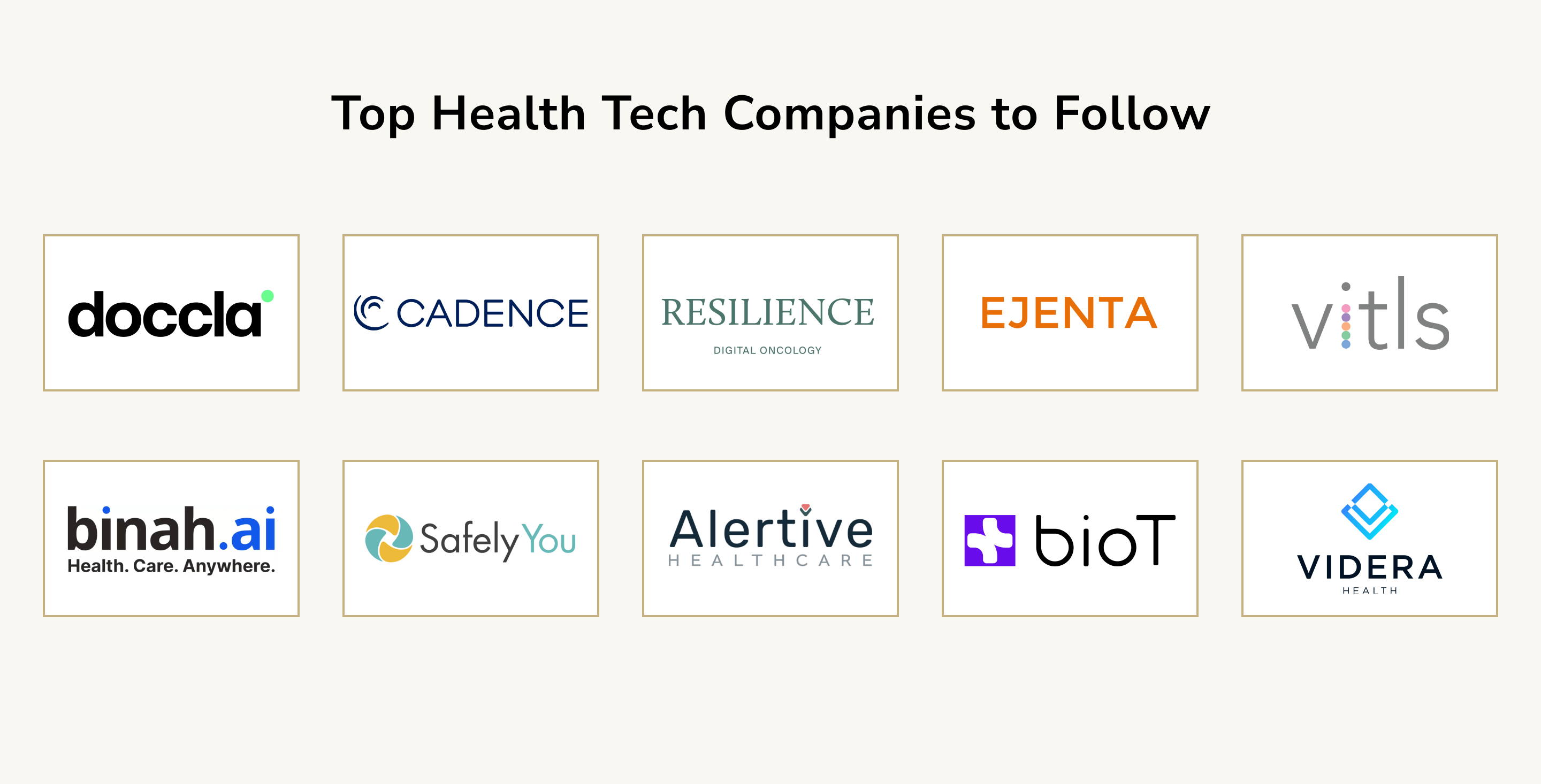
Doccla
Doccla is a health tech startup offering remote patient monitoring services applicable on hospital wards and in patients’ homes. Currently, the company secured about $3.3 million in investments and is ready to go big. The firm’s primary purpose is to predict when hospital beds will be freed through the switch toward remote health monitoring.
Doccla can boast of achieving about a 29% reduction in emergency admissions and a 20% reduction in A&E attendance for its clients. With its headquarters in London, the company can offer at least three unique outcomes. First, it is proven to increase the number of early discharges, which allows patients to come home easier and hospitals to decrease expenditures. Second, the firm proved to offer services resulting in fewer readmissions. Finally, Doccla uses medical-grade IoT devices within its Doccla Virtual Ward platform, which offers health monitoring at half of the cost.
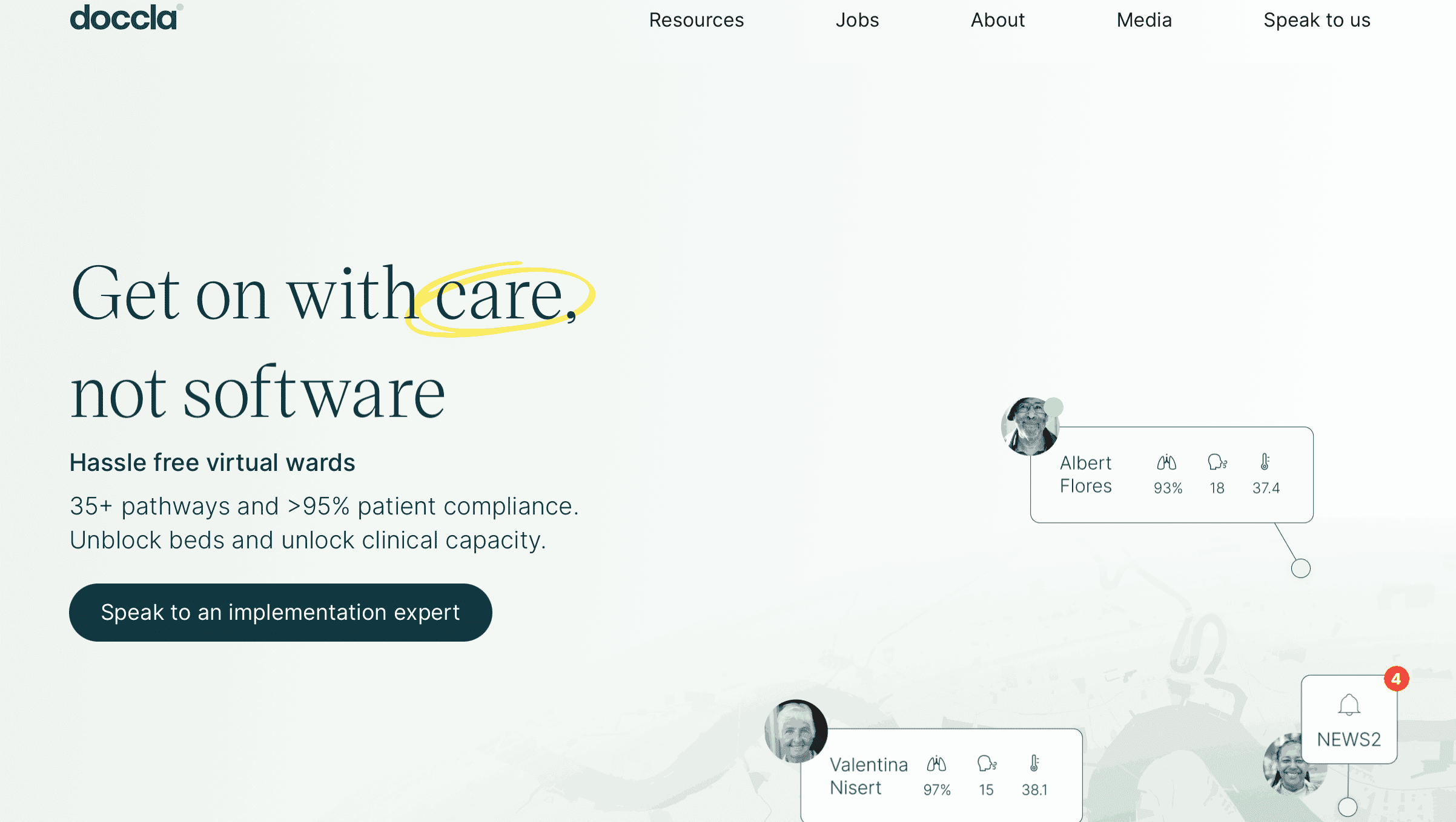
Cadence
Cadence is an all-in-one platform used for planning, executing, and experiencing in-person to virtual events. Cadence assures that with proper remote patient monitoring techniques the management of chronic conditions can be simple. It provides better and timely data that can be translated into more effective care plans. The company offers a number of features that can help bring the most of their remote patient monitoring tools:
- API
- Customizable branding
- Lead generation
- Real-time chat
- Recording
- Analytics
- Social media integration
With these features at hand, Candence ensures that the health tech market is closer to patients than ever before.
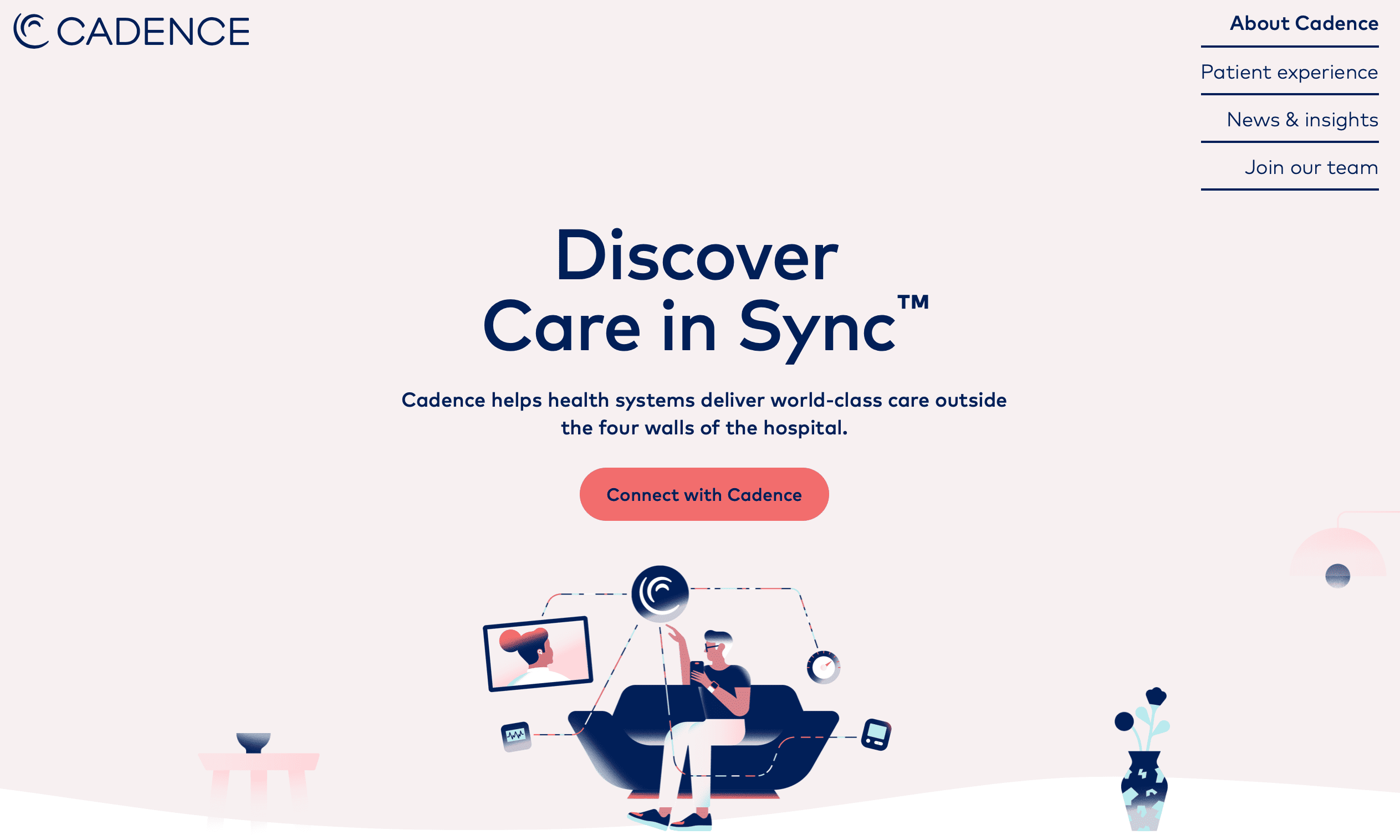
Resilience
Resilience is another health tech company worth speaking about. When it comes to the company’s boiler point, it dedicates its resources to helping people affected by cancer. In the course of such an important mission, the firm also fights any instances of unfair and discriminatory access to healthcare.
Resilience is considered a first-of-its-kind tech company directed at broadening access to complex medicines. It also ensures the protection of biopharmaceutical supply chains. Founded in 2020, within several years Resilience proved to be a worthy health tech start-up to deal with. The company uses remote patient monitoring technology within its mission to help cancer patients. Respectively, the approach makes the lives of the people with such a condition easier and grants greater access to timely healthcare provision, which is critical in cancer cases. Resilience is one of the companies that truly employ technological advances for the good of the people.
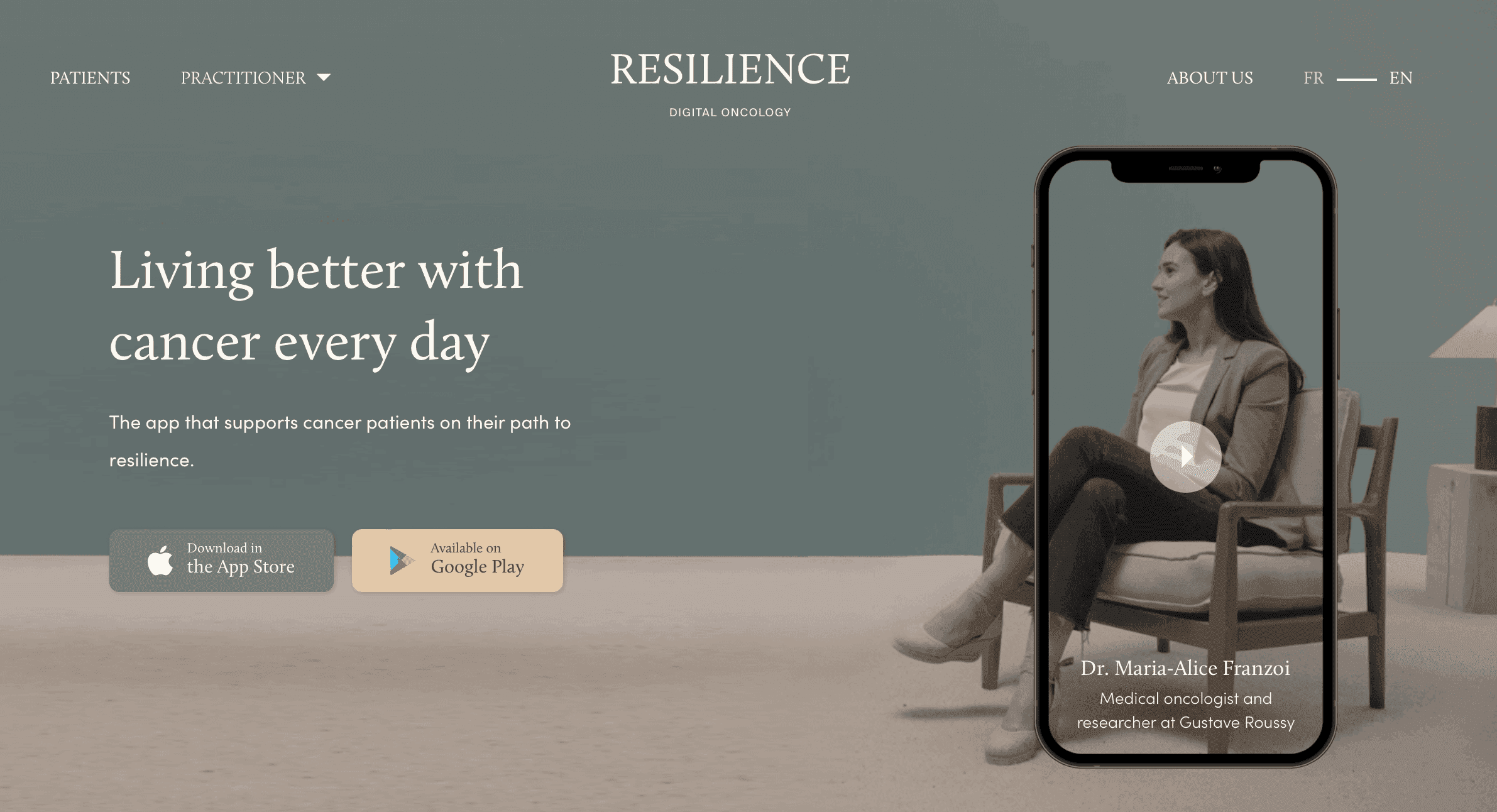
Ejenta
Ejenta is a health tech company representing itself as an intelligent agent for connected care. When delivering such an approach, the firm focuses on the usage of proven AI-based technology, personalized learning, and intelligent support. Ejenta indicates that their technology, the one used to deliver personalized care, was exclusively licensed by NASA. In terms of the “intelligent” part of the concept of intelligent care correlates to the utilization of data from sensors and IoT devices.
Ejenta uses an AI-based remote patient monitoring platform to understand users’ daily activities, monitor adherence to the care and medication plans, and offer highly personalized advice and coaching. When using Ejenta’s platform, users transfer biometric data via mobile devices, Smart TVs, and spoken natural language.
The company demonstrated the ability to improve patient lives, as well as make the life of clinicians easier. It is rapidly earning the trust of the medical industry and is expanding into large deployments with various healthcare providers across the United States.
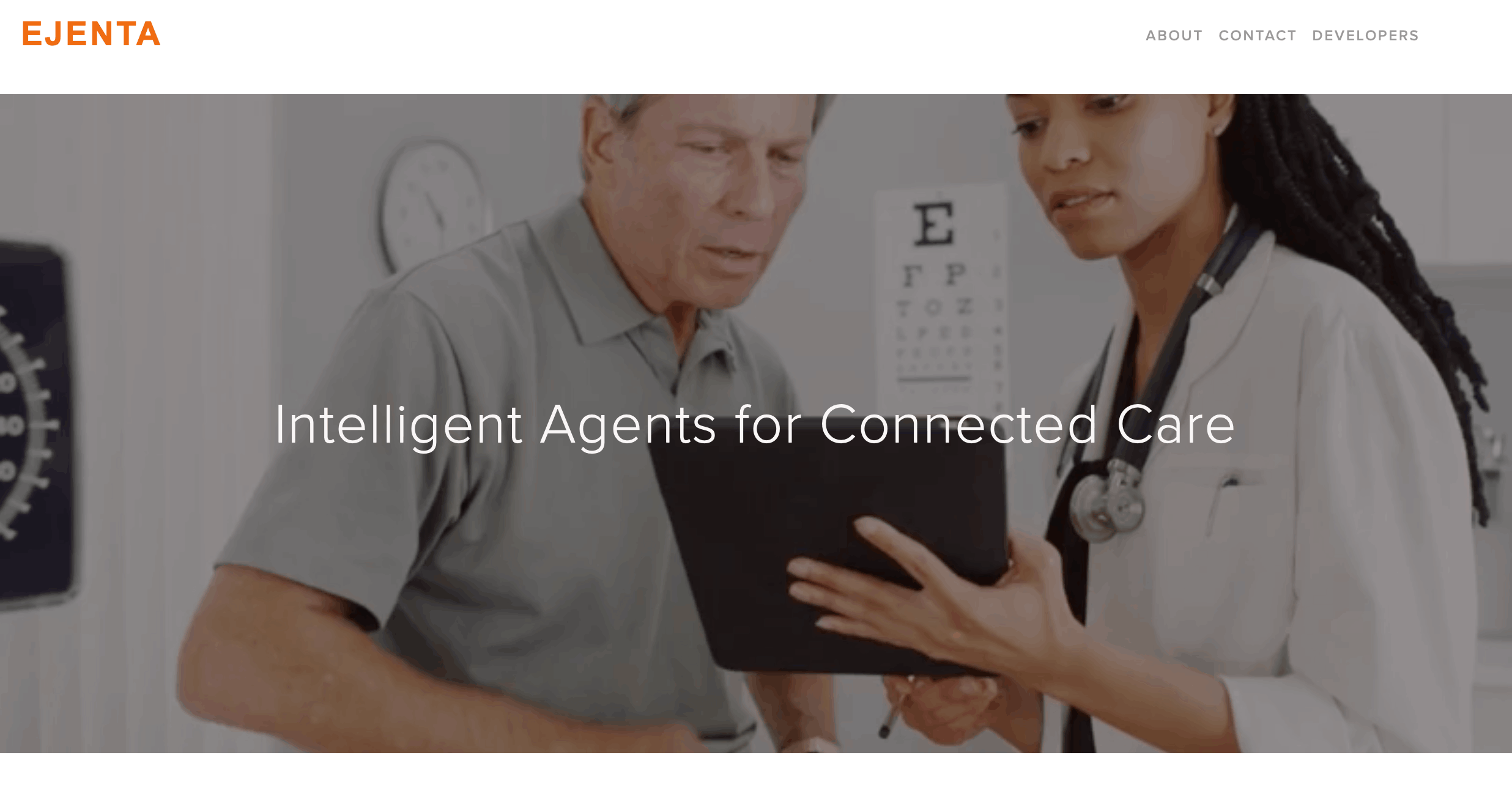
Vitls
Vitls is a platform allowing clinicians and nurses to continuously monitor a patient’s vital signs. The process is remote, reliable, and undistributed. It is a real-time process enabling the early detection of any signs of patient deterioration. As a result, it leads to a reduction in the length of stay in the hospital, thus decreasing the treatment cost. Vitls designed small, flexible, and waterproof wearable devices that collect seamless data without a person even noticing it. In addition, the collected data is sent to medical records systems along with any third-party systems.
There are several key features that Vitls offers making its services unique. For a relatively small price users receive a wearable device with the following features:
- Full suite of vitals
- Five-day battery life
- Wireless
- Waterproof
- Unobstructed
At this point, remote patient monitoring CMS proved to be beneficial. However, when using Vitls’s type of wearable device, the technology can be taken even further.

Binah.ai
Binah is an award-winning technology that is already shaping Digital Healthcare. It uses camera-equipped devices, for instance, smartphones, tablets, and laptops to analyze a user’s body vital signs. Binah’s video-based app removes the very need to have wearable devices. It can detect aspects like heart rate, mental stress, oxygen saturation, and respiratory rate by the means of analyzing a user’s face via video streaming. Besides, the health tech company uses the power of AI, including machine vision, machine learning, and deep learning to deliver innovative solutions to clinicians and patients.
Deep within its approach, Binah uses several key features that make its app work for the benefit of users:
- Light analysis
- Camera calibration
- Luminance correction
- ROI detection
- RGB data extraction
- Vital signs calculations
Binah has already proven its worth. That is why the company recently received the CES 2020 Innovation Award and was nominated as the 10th Open Innovation International Content 2020 grand champion.
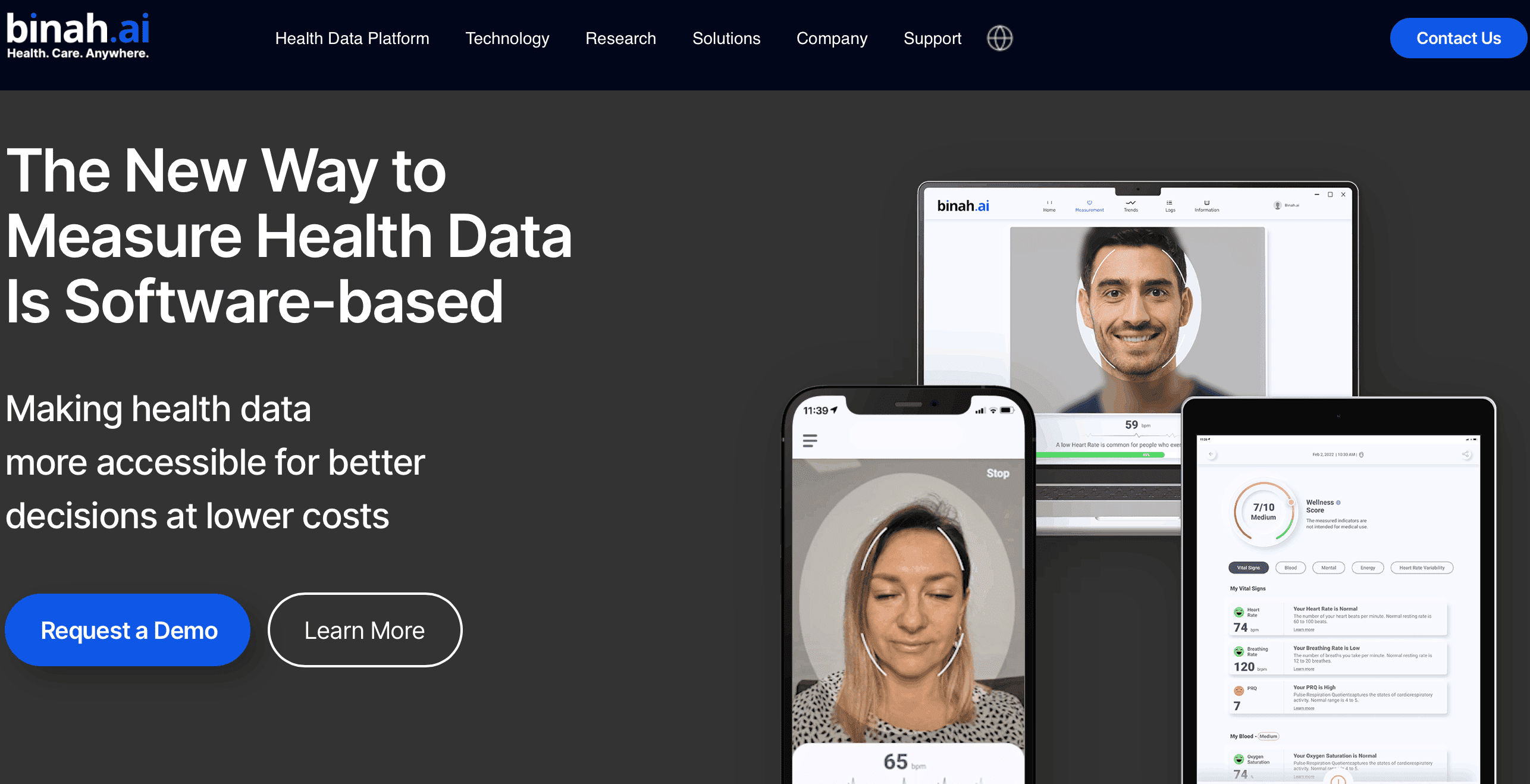
SafelyYou
SafelyYou is a health tech company that focuses on building a safer environment for people with dementia. It is also regarded as a fall management partner. The company uses AI-enabled video to prevent potential falls on a part of people with dementia. Another major focus is to understand the cause of falls among the vulnerable population. Importantly, with its groundbreaking technology, SafelyYou has already reached a 40% reduction in falls. What is more, the company managed to reduce the number of ER visits resulting from falls by 80%.
Speaking in numbers further, SafelyYou managed to detect more than 30,000 falls and offered a 99% accuracy. Recognizing the power and the prospects of the company, the health tech firm managed to achieve a $19.5 million investment. With SafelyYou, the numbers speak for themselves. The company works for the benefit of people with dementia and intends to expand its outreach further.
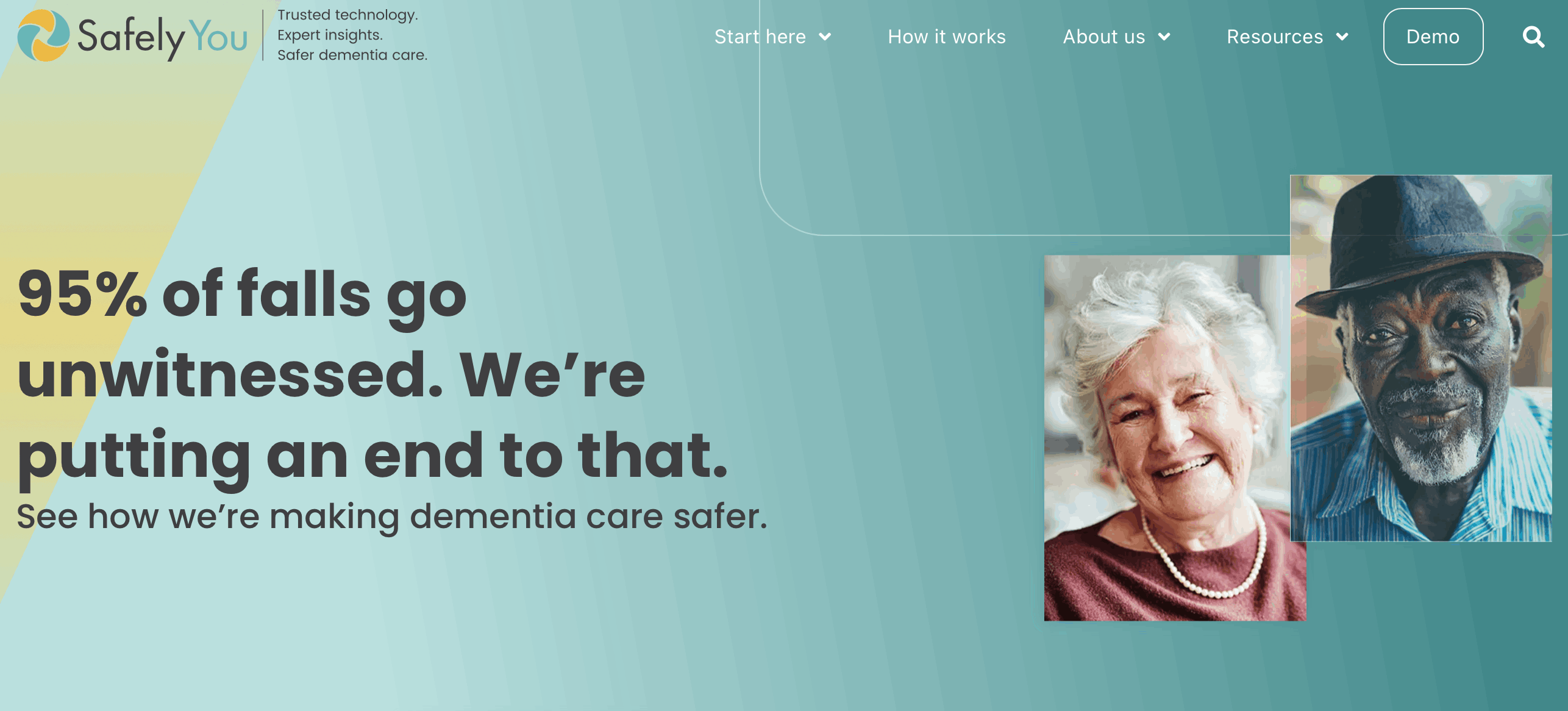
CoachCare
CoachCare is a health tech company focusing on remote patient monitoring for both healthcare facilities and individual practices. With a client base of more than 3,000 organisations that serve the patient base count of over 100,000, CoachCare can be confidently called one of the leaders of the market.
There are several specific domains on which CoachCare focuses:
- Remote patient monitoring. CoachCare RPM system includes such features as health tracking, video visits, claims support and documentation, and more. This comprehensive system is still customisable to cater the needs of healthcare facilities of various specialty.
- Monitoring and billing. These services take the unnecessary burden off of the shoulders of healthcare professionals and let them focus on what really matters.
- Virtual health. CoachCare software includes additional features such as automated alerts, digital library, synchronisation with various devices, etc.
All these elements ensure a full audit trail of patients’ health, which makes high-quality care provision possible. With its remote patient monitoring system, Coachcare managed to engage in effective care that translates into healthier patients and increased revenues for the company.

BioT Medical
BioT Medical is a self-service no-code connected-care platform. It is proven to be a game-changing solution based on the usage of wearable technology connected to the cloud. It all proves to save precious time. A medical-grade Platform-as-a-service (PaaS) uses a triple-c (connect-collaborate-care) approach allowing medical devices to be safely and remotely connected to a medical-grade cloud. As a result, it brings a boost in personalized engagement while improving health outcomes through collaboration between patients and care providers.
Respectively, BioT proved to save up to 80% of the time and cost-to-market for its clients. In addition to the standard package of features, the users receive cybersecurity updates, worldwide data privacy regulation changes, support of new reimbursement methodologies, cloud usage optimization, and feature enhancements.
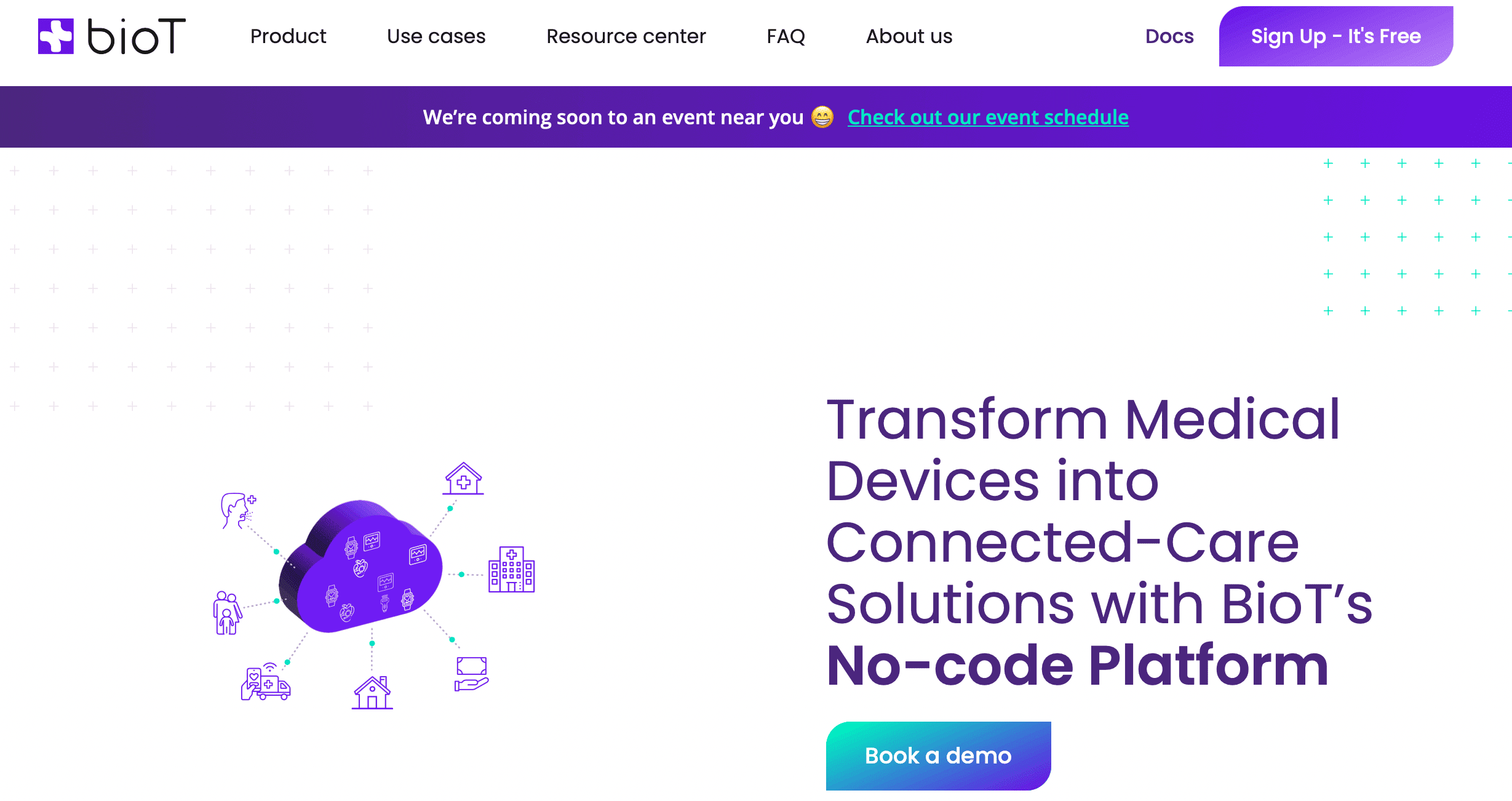
Videra Health
Videra Health is one of the top RPM programs that focuses on the digitalization of the traditional clinical evaluation process. It allows the gathering of rich qualitative patient data through video monitoring. Videra Health is an FDA-registered platform that puts an emphasis on helping patients with mental issues. When achieving its objectives, the platform focuses on:
- Providing created check-in assessments to avoid scheduling conflicts.
- Offers a built-in AI-assisted video analysis that shows which patients need the most immediate intervention.
- Creating the conditions when clinicians are alerted to patients who require immediate attention.
Videra Health is one of the mental health tech companies that use innovative technologies to help people who are most often stigmatized for their condition. The company manages to deliver solutions that can potentially help thousands of people with mental health issues.

A Promising Landscape of Remote Patient Monitoring Future
So, after reading this article, you have a general understanding of what is the contemporary state of remote patient monitoring market. But let's take a look into the future and ponder how remote patient monitoring will change the healthcare industry in the coming years.
- Rise of AI and Machine Learning. It's not surprising that the power and potential of artificial intelligence (AI) and machine learning (ML) algorithms are to be used to identify patterns, predict potential health risks, and recommend personalised treatment plans, leading to more efficient and effective care.
- Improved Accessibility and Affordability. Broader adoption of the technology and its benefits across diverse communities was one of the challenges for the field as so far RPM was not widely affordable. Technological advancements and innovative business models will make RPM more accessible for patients and healthcare providers.
- Deeper Integration with Healthcare Technologies. Wearable devices, telehealth platforms, and electronic health records (EHRs) will be seamlessly integrated into a broader digital healthcare ecosystem. It will provide a comprehensive view of a patient's health, facilitating informed decision-making and personalised interventions.
- Ethical Considerations. Careful consideration and proactive measures are necessary to ensure responsible and ethical implementation of RPM, with data privacy, potential biases in algorithms, and equitable access to the technology being the main challenges.
- More Sophisticated Sensors and Wearables. Early detection of health issues will be possible with the development of advanced sensors and wearables for more accurate monitoring of vital signs, physiological data, and biological markers.
- Expansion to New Areas. At the moment, RPM field is mostly focused on chronic conditions (such as diabetes and heart diseases). However, PRM begins to expand into new areas to cater patients that need assistance with mental health, respiratory conditions, and even post-surgical recovery.
Wrapping Up
The remote patient monitoring system is both the present and the future of healthcare. It makes the work of medical professionals easier, as well as the life of patients more comfortable. It has already proved to reduce aspects like scheduling conflicts and save precious time and money for health vendors. Remote patient monitoring software utilizes a number of features that utilize the power of IoT, AI, and wearable technology. It is apparent that remote patient monitoring technology is a good place for investment, as well as the technology that will make healthcare more efficient.
Interested in developing the best remote patient monitoring app or software? Impressit is ready to help — we offer first-class product development services.

Roman Zomko
Other articles